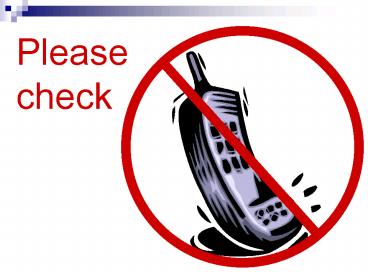Please check - PowerPoint PPT Presentation
1 / 32
Title:
Please check
Description:
Please use the COE Writing Lab if you have questions about ... acquaintances - in the family, in the 'hood, in the factory lunch room, in the bowling alley... – PowerPoint PPT presentation
Number of Views:41
Avg rating:3.0/5.0
Title: Please check
1
Please check
2
Todays topic
- Misconceptions Dialects, pidgins, and creoles
3
Announcements
- Observation assignment due in one week. Please
come and see me if you have questions. - Please use the COE Writing Lab if you have
questions about APA, formatting, grammatical
issues, etc. Please take a copy of the syllabus
and/or assignment with you. - Please turn in your article summary.
4
Remember!
- Your observation assignment will be due next
week. - Remember, for the final essay you will answer
FIVE questions - Questions 1 or 2,
- Questions 3 or 4,
- Question 5,
- Question 6 or 7, and
- Question 8.
- Also, we WILL be meeting on April 30th.
5
Quick questions or quandaries?
6
Semilingualism
- Have you ever heard someone use this term or one
that seems related?
7
Can't speak either language
limited language learner
alingual
bi-illiterate
double deficit
8
Why do people make these negative assumptions
about kids?
9
Or Maybe people dont understand what they see
and hear?
cultural differences
dialects
code switching
10
Could these be misinterpreted as semilingualism?
- Non-standard dialects
- Code-switching
- Cultural differences in narrative structure
- Influence of the interactional context on
culturally diverse individuals - Normal patterns of bilingual language
development, including first language attrition.
11
Non-standard dialects
There is English, and there is bad English. Its
either one or the other. Bad English, either
spoken or written, needs for it to be corrected
to become good, decent, proper English - the kind
taught in schools, used in textbooks and relied
upon in commerce. Bad English is useful in a
small circle of friends or acquaintances - in the
family, in the hood, in the factory lunch room,
in the bowling alley Bad English is acceptable
if you aspire to drive a taxi in Washington.
---Chuck Greene, The Denver Post, 12/22/96
12
Ignorance is not confined to linguistic
curmudgeons
You dont have to go to school to learn to talk
garbage
--- Jesse Jackson (the Denver Post, 12/22/96)
13
Thats just WRONG.
According to linguists there are no "primitive"
languages or language varieties -- all
languages are equally complex and equally capable
of expressing any idea in the universe. The
vocabulary of any language can be expanded to
include new words for new concepts.
Fromkin Rodman, 1988, p. 18
14
Two ways to look at language
Descriptive
- Prescriptive
(is)
(should be)
15
Why does this matter?
- When assessing childrens language competence, we
MUST compare their abilities with the language
varieties they have been exposed to, whether or
not that is the standard dialect. - We can assess childrens acquisition of the
standard dialect for developing instructional
programs, but not for diagnostic purposes.
16
Lingua Francas, Pidgins and Creoles
- A lingua franca is a language which is used as a
means of communication among people who have no
native language in common. - A pidgin language is a lingua franca which has no
native speakers. - Creole languages are pidgins that have acquired
native speakers.
From Gumperz, J. (1983). Sociolinguistics An
introduction to language and society. New York
Penguin Books. (pp. 157, 179-182.)
17
Switzerland and her neighbors
French
Italian
18
North Country (Northlandish)
Riverbank South
Riverbank North
South Country (Southlandish)
19
Barriers
- Geographic
- Political
- Social
20
Quick Write
- How does the discussion of non-standard language
varieties pertain to teaching English Language
Learners in our schools?
21
I-R-E
- teacher INITIATION
- student RESPONSE
- teacher EVALUATION
22
Small Group Activity
- Compare and contrast the two transcripts (big
sweets and little sweets and Baby Jesus). How
are they different? Which one seems more like IRE
(or recitation script)? Which one elicits more
language for Lynne? Why? Which one would foster
language development more? Why?
23
Compare that with
P B J!
24
How is the teacher-student interaction during the
PB J clip different from the Big Sweets
lesson?
Quick Question
25
What's the problem with recitation script?
26
Instructional Conversation (IC)
"Talk in which ideas are explored rather than
answers to teachers' test questions provided and
evaluated."
(Cazden, 1988, p. 54)
27
Characteristics of IC
- It is interesting and engaging.
- It is about an idea or a concept that has meaning
and relevance for students.
28
Characteristics of IC
- It has a focus that, while it may shift as the
discussion evolves, remains discernible
throughout. - There is a high level of participation, without
undue domination by any one individual,
particularly the teacher.
29
Characteristics of IC
- Students engage in extended discussion
conversations with the teacher and among
themselves.
(Goldenberg, 1991, p. 3)
30
Small Group Activity 2
- Compare and contrast recitation script and
instructional conversation. Which provides more
opportunities to foster students language
development? Why? What are some ideas for
implementing instructional conversation in the
classroom?
31
Looking ahead
- Code-switching
32
- .
Please take a minute for the minute paper.











![Read [PDF] Fracked!: Or: Please Don't Use the F-Word (Modern PowerPoint PPT Presentation](https://s3.amazonaws.com/images.powershow.com/10092132.th0.jpg?_=20240803115)



















